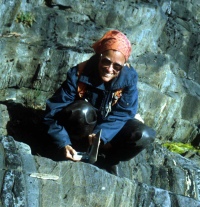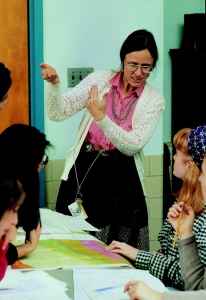About

Maria Luisa Crawford
Maria Luisa Crawford WF ’60, Professor Emerita, Geology, Bryn Mawr College; MacArthur Fellow.
Mountains of Work: Maria Luisa Crawford WF ’60 shapes a field
It’s easy to see a mountain as a monolith, solid and unchanging. But geologist Maria Luisa Crawford WF ’60 has spent an entire career studying the origin—and the ongoing evolution—of mountains.
During her 40-year career, Dr. Crawford has conducted research on mountain ranges from southeast Pennsylvania—“where the mountains have been eroded down to the deep roots that once resided about 30 kilometers under the surface”—to Alaska—“where the mountain chain between Prince Rupert, British Columbia and Juneau, Alaska was constructed during the last 100 million years.” She focuses particularly on metamorphism, “the changes in rocks as they are heated and buried during the development of the mountain… and then return to the surface.” She also conducted research in Oslo, Norway on a Fulbright Scholarship. In 1993, she received a MacArthur Fellowship, the internationally known “genius grant.”
Dr. Crawford’s interests, like the mountains she studies, have changed dramatically over time. For a time, she studied some of the first moon rocks that were brought to earth, and some of that early work is still cited in lunar studies. Soon enough, however, she decided that “I preferred to be investigating issues when I could see the rocks involved and their context personally.” Within the past decade, she has also been part of the ongoing effort to create GEON, a massive geoinformatics system that uses supercomputing to store and coordinate data across the earth sciences.
As with most fields in science, technology has changed geology significantly, Dr. Crawford says. “My field has changed through advances in experiments on what rocks undergo as they are heated and compressed, advances in understanding the processes of plate tectonics and changes in data observed and deciphered by other geologists working in areas similar to the ones I study.” Some of the evolution in her field, however, have been less about technology and more about teamwork. “One of the changes for me,” she notes,“has been the greater collaboration among geoscientists with a variety of skills and expertise working on problems in one area.” One example: working with colleagues to determine how continental drift has caused metamorphism in the mountains she’s studied.
Awarded her Woodrow Wilson Fellowship in 1960 while at Bryn Mawr College, Dr. Crawford did her doctoral work at the University of California. One of few women in a male-dominated field, she was not intimidated. “Since I was at an undergraduate college that was mostly female students, I did not feel in any way inhibited by the lack of role models once I progressed to graduate studies and professional work.” While there are more women in science today than when Dr. Crawford entered the field, the number of women in geoscience, she says, still remains small. “Geology may be more challenging than some fields due to the need for work in the outdoors, sometimes in very challenging ircumstances. Also geology is one of the careers that seem to require more quantitative abilities and thus somehow results in being less attractive.” Engineering, she observes, likewise continues to attract a relatively low number of women.
To assist women who are pursuing careers in geoscience, Dr. Crawford and her husband, also a noted geologist, have established the Crawford Field Camp Scholarship. Awarded through the Association of Women Geoscientists and the National Association of Geoscience Teachers, the scholarship helps offset field camp expenses for female geoscientists.
 “I am not sure that engaging student interest in science earlier is much of the answer, given that many of the issues that result in women not continuing into a career in science involve lifestyle choices that arise after the college years,” says Dr. Crawford of how to address the shortage of female scientists. Without children, she points out, “I had a different career track than many women colleagues…. Also I had a very supportive spouse with whom I shared much in my professional career. We were equals all along the way.”
“I am not sure that engaging student interest in science earlier is much of the answer, given that many of the issues that result in women not continuing into a career in science involve lifestyle choices that arise after the college years,” says Dr. Crawford of how to address the shortage of female scientists. Without children, she points out, “I had a different career track than many women colleagues…. Also I had a very supportive spouse with whom I shared much in my professional career. We were equals all along the way.”
Dr. Crawford and her husband, William A. Crawford, are both Bryn Mawr professors emeriti. Having retired from teaching in 2006, she still serves as mineral curator for Bryn Mawr. She also works with school groups and assists undergraduates when needed. While Dr. Crawford no longer conducts field research, she often gives lectures about geological features and geological history when traveling. Next year, she’ll lead a group of Bryn Mawr alumnae/i to Iceland. “I continue trying to convey to all I meet how wonderful and complex Earth is and the many ways it influences our lives and how we influence it. This should be a part of everyone’s understanding.”

